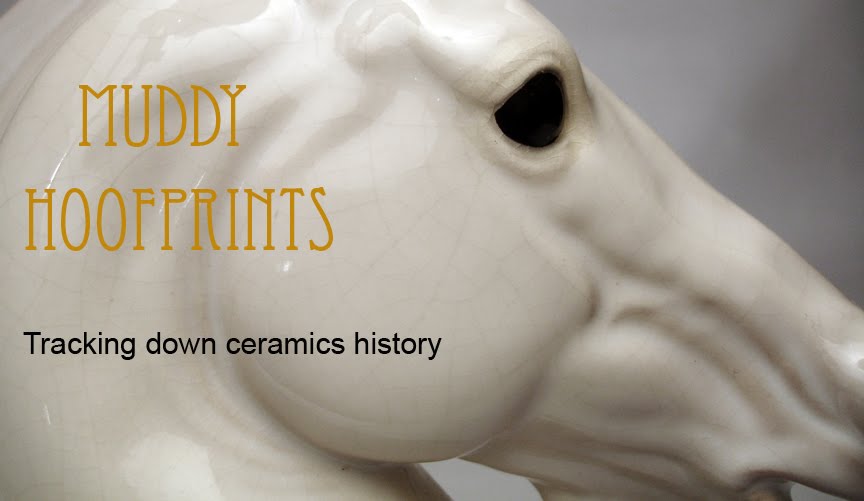Perfection is something devoted potters aspire to, but seldom attain. In mass production pottery, we accept a bit more error than is expected from today's small, artist-run potteries. A single specialist has more time to devote to each piece than a factory worker does. Please keep in mind, this is not a condemnation of mass production pottery! Production fills a market need that smaller studios could never fill, without becoming larger companies and hiring a lot of people.
Production pottery approaches the tedious job of seaming the raw castings with speed. A wet sponge and a small, bladed tool (too many variants to list) pretty much does the job. We often see seaming artifacts left by these two types of tools.
Heavy sponge work looks like a patch of super-fine, parallel lines. The sponge was swept broadly across or down seam lines, to blend them into the surrounding surfaces.
San Marcos Metalchex
San Dimas Crusader
When airbrushing picks it up as surface texture, it can have neat effects. Because the lines are recessed scratches, decorator handling can rub off the raw underglaze on the upper surfaces, created the pigmented lines in these examples.
San Dimas Sun Cortez
The yellow line running down the horse is the location of the actual seam line. You can see it not because it is raised, but because the poured clay sets up slightly more dense, along the mold's parting lines. The yellow is really just dense white clay slip. In this next sponged example, the dark gray line is the denser slip seam.
Monrovia rose gray Sheba
Model courtesy Janet Hicks.
It is dangerously easy to wipe out mold detail with a sponge. As you can see, this is a nicely detailed Daisy.
Monrovia Daisy
She even has fur detail on her neck and on the underside of her blowing mane. Look what spongeing has done to her shoulder, where the seam runs.
A wet sponge on a wet casting can literally wipe the face off.
Smeared like cake icing!
Miniature Turning Mustang
Nice detail, on this side.
Sponged, on this side.
This is actually not nearly as smoothed as most 6" Zara models.
This Abdullah has nice detail, as you can tell from his face,
but a sponge smoothed out part of his mane.
Model courtesy Janet Hicks.
See those tiny bumps on Abdullah's cheek, above? The action of the sponge wipe removes the fine, outer layer of silt that gives slipcast surfaces their smoothness. The inner grog of the clay (the larger, harder mineral particles) are exposed, and appear as tiny pebbles in the newly-swept surface.
Monrovia Swaps
San Marcos Harry with sponge swipes.
This one got a little bit Toasty, too. His grog has turned white and is raised.
This lightly-sponged horse has less exposed grog, and with a gloss glaze, it looks almost like a Chinese drip glaze.
San Marcos gloss chestnut QH Mare
A dry sponge on a moist greenware casting produces this effect.
San Dimas Sun Cortez
Bladed tool work looks like long, flat unnatural facets.
That's not her spine. That's one continuous blade facet.
Too quick with the blade, and you lose a chunk of hoof.
The facet that ended abruptly with hoof removal is visible on the leg.
Model courtesy Janet Hicks.
Sometimes, you get both on the same spot, on one horse.
San Dimas Swaps
San Dimas Sun Cortez
Oops! Forgot a seam!
San Marcos bisque Lippitt
The next seams were not forgotten, they were diligently cleared off the greenware. However, during firing, the denser clay along the seam raised from the rest of the surface.
Monrovia Swaps
This one is more noticeable because decoration smeared across the raised seam.
San Dimas "pinto" Butch, model courtesy Janet Hicks.
Sponge swipes and popped seam.
San Dimas bisque Comella
These are not seams.
Hard spots on back and side of 6" doeskin Zara.
Hard spots are the first places where the wet slip hits, when it is poured inside a mold. The pigment is darker because the clay is denser there, as along seams. I think it's safe to say the side one was a splash from the initial back hit.
Another false seam is made by the pigment and mineral layers of imperfectly-mixed liquid slip. Some people call this the "woodgrain effect". It is not intentionally done, it's just that the slip could have used more stirring before it was poured in the mold. This occurs on tinted and on pure white slips, as you can see.
San Dimas Amir
Large hard spot on chest of dark buckskin Metalchex.
Does this mean he was poured through his butt?
I had to really take a look at his tail, which could be the plug... a topic for another day!
This examination of what some ceramic production artifacts look like, and the insight into their causes, may be of help to you when purchasing ceramics, or evaluating your potential show horses. On the latter, I urge you to be very picky. You want to bring out your best to wow a judge. A live show judge is going to check that your entry has two eyes, not just one and a smear. With the more common HRs, there may be three or more identical models in the same class. If you have a model with extremely noticeable tool marks, or lost detail, it is probably not going to place favorably against the same horses with better (or unnoticeable) seams.
While I'm not new to ceramics production (cleaning greenware professionally since 1995), I can't possibly know everything. If you have more information on how and why some of these happened, or the HR employee training process, I'd love to read about it.
































No comments:
Post a Comment